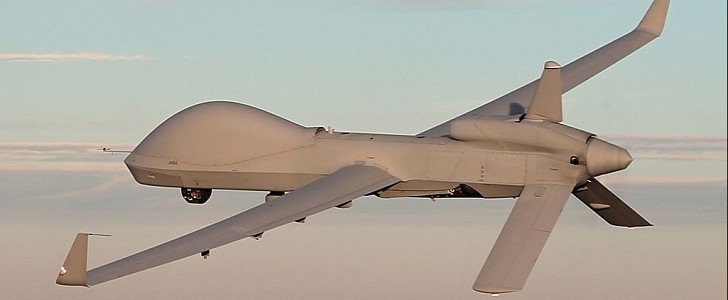Defense contractor General Atomics Aeronautical Systems (GA-ASI) successfully demonstrated enhanced situational awareness and targeting capability of an MQ-1C Gray Eagle in a recent exercise. The Extended Range drone was remotely controlled via an Android-powered tablet by a soldier on ground.
Widely used by the U.S. Army, the Gray Eagle can operate for about 36 hours at altitudes up to 25,000 feet (7,600 m). The aircraft's nose fairing is enlarged to support a synthetic aperture radar or ground moving target indicator (SAR/GMTI) system.
It has a payload capacity of 800 pounds (360 kg) and can be armed with AGM-114 Hellfire missiles and GBU-44/B Viper Strike guided bombs. Its sensors can detect changes in terrain such as tire tracks, footprints, and buried improvised explosive devices by fusing infrared imagery.
GA-ASI latest demonstration took place on April 23rd at Yuma Proving Grounds, Arizona. A Joint Terminal Attack Controller (JTAC) – a service member who directs the aircraft from a forward position in a military operation – managed the electro-optical and infrared sensors on a Gray Eagle Extended Range (GE-ER) Unmanned Aircraft System (UAS). The soldier was also able to rapidly call for direct and indirect fire on a range of targets.
With the touch of a few buttons, the JTAC sent a digital 'Call for Fires' to request artillery support and a digital 9-line for Close Air Support. The soldier could also see GE-ER video, the aircraft's position, and sensor field of regard by using an Android Team Awareness Kit (ATAK) tablet and a TrellisWare TW-950 TSM Shadow radio. Without any commands from the GE-ER operator, the drone re-routed its flight path to provide the sensor data requested by the JTAC.
Compared to the use of voice communications, this newly developed technology represents a major advancement in situational awareness: the technology improved efficiency, reduced latency, and reduced risk of collateral damage. Furthermore, the JTAC's ability to orient GE-ER sensors on targets from an ATAK tablet eliminates man-in-the-loop errors and speeds up targeting.
It has a payload capacity of 800 pounds (360 kg) and can be armed with AGM-114 Hellfire missiles and GBU-44/B Viper Strike guided bombs. Its sensors can detect changes in terrain such as tire tracks, footprints, and buried improvised explosive devices by fusing infrared imagery.
GA-ASI latest demonstration took place on April 23rd at Yuma Proving Grounds, Arizona. A Joint Terminal Attack Controller (JTAC) – a service member who directs the aircraft from a forward position in a military operation – managed the electro-optical and infrared sensors on a Gray Eagle Extended Range (GE-ER) Unmanned Aircraft System (UAS). The soldier was also able to rapidly call for direct and indirect fire on a range of targets.
With the touch of a few buttons, the JTAC sent a digital 'Call for Fires' to request artillery support and a digital 9-line for Close Air Support. The soldier could also see GE-ER video, the aircraft's position, and sensor field of regard by using an Android Team Awareness Kit (ATAK) tablet and a TrellisWare TW-950 TSM Shadow radio. Without any commands from the GE-ER operator, the drone re-routed its flight path to provide the sensor data requested by the JTAC.
Compared to the use of voice communications, this newly developed technology represents a major advancement in situational awareness: the technology improved efficiency, reduced latency, and reduced risk of collateral damage. Furthermore, the JTAC's ability to orient GE-ER sensors on targets from an ATAK tablet eliminates man-in-the-loop errors and speeds up targeting.








